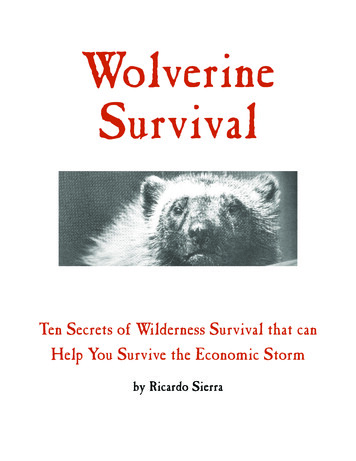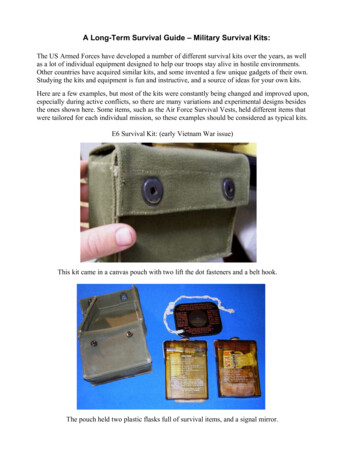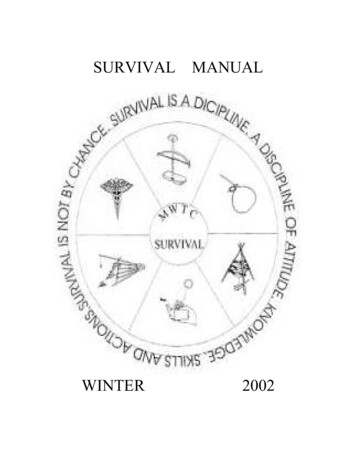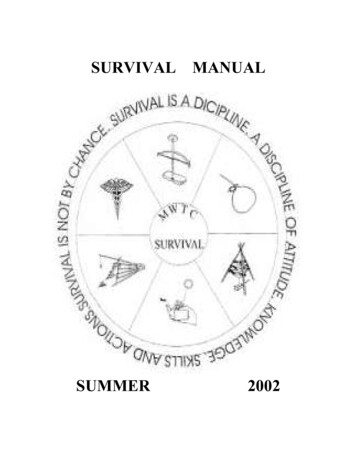
Transcription
WolverineSurvivalTen Secrets of Wilderness Survival that canHelp You Survive the Economic Stormby Ricardo Sierra
IntroductionWhen I first started my studies in wilderness survival and nature awareness, I focused on theminute details of staying alive. I studied many ways of making fire without matches, carefullycarving a bow or studying the grains of sand inside of a coyote track. I took notes fastidiouslyin my journals, made diagrams and read everything I could get my hands on that might help meget any edge on growing my skills. I don’t know exactly why I was so passionate. Lookingback, I know it was an incredible rush to learn and grow. I saw my skills expand in leaps andbounds, sometimes after just a few days of study and practice.It was addictive and powerful, and the energy it created was infectious. Each discovery wassweet and satisfying Twenty years have passed since I started teaching wilderness survival to youth and adults, andmy learning has gone from woods lore and skills to business problem solving, management andstrategic planning. I still get out and follow a trail in the grass or snow,and make lots of crafts, but much of my learning lies in the areaof relationships, communication and teaching.However, the underlying lessons of wilderness survivalhave never left me, and the principles that are buriedwithin have never let me down, just like the art of firewithout matches. They are based on natural law, natural truths that hold up in the test of time, underintense scrutiny. They have helped me in moreways than I can list.My first teacher in survival, Tom Brown, Jr., spoke ofhow animals provided powerful teachings to nativepeople, in areas of movement (foxes), stalking (herons),observation (hawks), hunting (wolves), or edible &medicinal plants (bears). However, it was the wolverinethat held inspiration for him, as, pound for pound, it is oneof the most powerful hunters, scavengers and survival masters.Wolverines have spawned countless stories of fierce battles withwolf packs, grizzlies, moose, hunters and trappers, and it’s role in our psyche is well established.It’s fearless approach to life seems to prove that intelligence, boldness and attitude often outperforms the more conservative approaches used by others. For a long time, I held the wolverinein great esteem, thinking it was the ultimate survivor.However, I have learned that it’s not the size or the fierceness that always make the difference.A chickadee is just as amazing and survives in the dead of winter, subzero temperatures, livingon frozen bugs plucked off of tree branches or seeds. It isn’t particularly threatening or aggressive, either! It lives in small groups, working cooperatively, always cheerful and friendly to others, unafraid of impending storms and difficult conditions. I don’t know which I admire more,Page 1
and I am glad I don’t have to choose. Both are powerful teachers who can inspire us to livewithout fear in the wild places of our lives.I wrote this guide because the approaching storm is huge and will sweep many up in the flotsamof flooding, despair and terror, and the conditions are exactly like those found in a survival situation. Cut off from the usual means of food, comfort, security, we can experience profound fearand struggle. By using the concepts found in the following pages, I hope to give you alternatives. Survival isn’t what most people think, and those that can control their fear and find waysto act strategically can find ways to survive and thrive.I am not promising that you will get everything you ever dreamed of just by reading this guide,because sometimes the world needs to change, or make major shifts, and nothing can stop thoseforces from happening. Like the Howe Brothers teach in surfing, “It might be a small wave, ora big wave, but there isn’t a person alive who can stop those waves from coming.” Economicstorms are like thunderstorms, or hurricanes, or blizzards. Sometimes they can be like anextended drought, even. Sometimes, the storm can be self-induced, through lack of energy orability to grow. Storms are huge, and cover everything in sight, in all directions, with few routesof escape, forcing us to change and grow.My hope remains that you will find something in this guide that you cantake with you, that you can apply and use, that will, in a real way, helpyour organization, your business, your family or your friends. I hopeit helps you to live, if not without fear, atleast with less fear. I want youto instead act in trust, in a positive, proactive way, that is a model ofleadership, hope and strength to those around you.If you are able to get something useful from this, please send us a donation to our scholarship fund, if you are able. You can do it online, on ourwebsite, and it takes just a few minutes. Also, please write and share your ownexperiences on my blog, or just e-mail me. Your success and your story can inspire and help others, and we need those stories to continue to inspire us all! I am happy to keep you anonymous,if you prefer. But by all means, please share your success. It takes two minutes and willensure that this ‘good medicine’ as they say, is passed forward.Special thanks to Tom Brown, Jr., John Stokes, Frank and Karen Sherwood, Jake Swamp, Jim LaVallee, thefamily of Hawk Circle staff, volunteers and students and my wife, Trista Haggerty. I don’t know where Iwould be without your advice, teachings, insight and indominable spirit!Enjoy the guide.-Ricardo SierraCherry Valley, January 30th, 2009Page 2
OneTo a modern person, a wilderness area can seem like a barren place, devoid of the comforts thathe or she is accustomed, and lacking in all modern conveniences. However, to a skilled wilderness instructor, guide or native person, the wild has everything we need to survive, even thrive.One of the first things that it is helpful to remember is this first key concept:There’s Always Something Even in the most remote area of North America, there are things to make a shelter, find water,gather food and make fire. Sometimes, as in the Far North, the Arctic Circle, fire was used fromthe seal fat, whale or walrus oil, as there are no trees for firewood for hundreds of miles.Sometimes fire doesn’t look like fire as we know it, but it is still fire. And there is always something that we can use to help us survive. We just have to learn to see it, to recognize it for whatit is, and find ways for it to help us thrive and grow.When you understand this concept, and internalize it, you will go from looking around glumlyand complaining, (victim mentality) to being open, searching and excited about what new opportunity or resource can help you next. You will be active and awake to the fact that possibilitiesare constantly moving around us and you will be in a position to take advantage of them.Without this as a core philosophy, as a practice, you will miss out on opportunities that are rightin front of you.One time I was traveling to a school to lead a hands-on native crafts activity presentation. It was my fourth class in a series of programs. I got to the school a littleearly, and went to the back of my car to get my materials. My heart sank as Ilooked in and found that I was missing two of the three boxes of my needed supplies.They were taken by mistake by some staff who had gone to another school earlier thatday.I felt like a deer in the headlights, frozen for a few seconds.What to do, what to do?However, I didn’t panic. I looked around the school grounds, then across the road.There was a field and a small stream nearby, and I headed over to check it out.I gathered a handful of rocks for stone tools, about ten straight sticks for arrow shaftsand some flexible willow and red oosier dogwood branches. We took the string andfeathers from my remaining craft box, and had a great afternoon scraping smootharrow shafts and fletching these with feathers for a while, then made beautiful hoops from the willow anddogwood for our dream catchers. It was probably the best class of the series.Page 4
You will note that I didn’t use my few moments of time to complain, or call the other staff asking why they took my supplies. I didn’t use that time to feel bad, or sorry for myself either. Isimply took the time to focus and look around with all of my skills and awareness. I gavemyself a moment, a space apart from the stress of the impending program needs, and justlooked around.An important way to develop this core philosophy is to practice it as often as you can. In ourwilderness programs we will regularly take a few minutes during a hike or walk or at almostany time, and have our students build a fire.It could be with flint & steel, or a bow drillor hand drill method, or even matches.They have to gather dry tinder, build a smallfire and do it quickly, in five minutes or less.When they practice this as a skill, at firstthey get a little stressed out, but after a fewtimes through, they begin to focus on finding what they need, and a lot less time onstressing out. They just get to work makingit happen. We practice it over and over, andsurprisingly, the students fail to notice how,no matter where they go or what the weather, they are able to find what they need tomake a fire.Internalizing this belief through repeated positive reinforcements of this message shapes one’sapproach to finding solutions in future situations. In the case of fire, students begin to buildtrust in the earth, or the world, to provide help for us when we have a need. Whether you callit faith, or trust, or just a belief in your own ability to find what you need, this is important tonurture and practice, from a young age on through adulthood. It can be repeated in otherskills, like finding shelter, food or any number of tools, fibers or water.Remember: There is always something around (to help us, if we don’t panic and take thetime to look closely!) Look around with a sense of wonder and discovery and see what youcan find. It is usually closer than you think!Page 5
TwoThe second core concept is vital to keeping your mindset positive during an emergency orwilderness situation.It’s calledSeparating your Wants from your Needs.Simply put, if you are thrust into a wilderness survival situation, you have to throw expectations out the window and get down to your most basic, core needs. You might want a softmattress and a down comforter, but what you need is a bed of dry leaves and sticks to takeshelter in for the night. You might want a pizza but you only need a handful of berries tomake it through the day.Translation: If your survival outlook is grim, you have to cut out the daily 7 cups of coffee, and havebrown rice and beans for dinner a few nights a week. You might have to share rides, or turn down thethermostat.This is hard to do. We are used to having it all. Maybe we have just absorbed too many marketing messages that tell us that we can have it our way, or whatever, but the facts, when distilled, are this: We have the ability to go for long periods with little food, walking great distances, sit still for hours waiting for game, and most of us never test our own limits. I am notsuggesting that suffering is good for the soul or whatever, but I am saying that if times arehard, you can’t reward yourself with a 7 cup of coffee each day just for getting up in the morning. Sometimes you have to make your own coffee, and learn to reward yourself in otherways!Only you can determine your actual, rock bottomneeds, but you have to be brutally honest in orderto find your bottom line and work from there.It’s actually liberating and enlightening.You can do this in a number of different ways. Itall depends on how intense your conservationneeds are, your income needs, and more. Youmight have to cut back on food, or commutingcosts, or clothing. It could come in other areas,such as finding a roommate, or boarder. Therecould be a lot of different ways that your life or your family, or your business or organizationhas wants and expectations that are not true needs, and you might have to talk everything overwith your ‘tribe’ and see what can be cut, what can be kept and what you all simply can’t livewithout.It is hard work, but it can be fun too, because, as the saying goes: “The truth shall set you free!”Working from a true needs base, you now have room to grow, expand and work within yourlimits.Page 6
Why is this important? Well, to begin with, once you know your needs, you can set about takingcare of them. But that isn’t the most important part. The key is the mental part of this ‘secret’!Ask yourself how not having your needs met, impacts your mental state? I know I need a certainamount of security to feel a baseline sense of well-being and ‘space’ in my daily life. When I amin a survival situation, I know I have to make an adjustment so that my mind can understand,and then let go of what might be unrealistic expectations. Without that shift, I am subjectingmyself to being off balance.Think of a child on Christmas morning. Here he or she is, surrounded by caring family, lots ofpresents, plenty of food and a warm house in winter, and yet, he or she can be completely debilitated by not getting the expected present! It is a classic example of how our emotions cloud ourreality and lead us in directions that don’t serve us.There are times when the shelter of society is good for us. However, too much protection from‘reality’ builds up unrealistic ideas of how the world ‘should be’, and the clouding begins. Beforewe know it, we are far from the road, if you know what I mean.At our summer camps or school programs, it is common to find that a third of the young peopleare actually very anxious about coming to the ‘wilderness’ and being separated from their electronic means of communication, from their sodas and push button entertainment and preferredsnack foods. Being at camp is very new and to be cut off from the comforts of our lives can bechallenging. However, by the end of the program, those same students are usually the ones whoappreciated the simplicity of cooking an apple on a stick over the campfire, drinking spring water,walking everywhere and finding friends in face to face connections shared on the trail or in thelean-to. The starlight, storytelling and good food all combine to give a new baseline of what ‘I’mokay’ looks like to these kids.Maybe this whole economic storm is just a huge adjustment for our culture to separate our wantsand needs? Maybe this whole experience we are going through is actually a good thing, something we can survive and then build upon to help us all be stronger, get better, and create the liveswe really need.Page 7
ThreeCreativity and Problem SolvingThe human being is an incredible species. We have the ability to adapt to almost every regionon this planet, from the jungles of the Equator, to the deserts and mountains, and even theArctic polar regions. While most of us live in a temperate zone, with the comforts and aid of anextremely forgiving societal safety net, the native peoples in these extreme areas lived with nextto nothing, in some of the harshest climates imaginable, and managed to do quite well.Take, for example, the Inuit, or the Inu, or any other northern native group. They live withalmost no wood for bows, sleds, shelters or crafts. The predominant feature in winter is snowand ice, and in the summer the landscape is wet bogs, sparse shrubbery, tundra and grass. Inmy book, they are the McGiver people. (Remember the guy who could get himself out of diresituations with just a paper clip, a pencil, a roll of duct tape and four spools of thread?) Out oftheir region’s meager resources, they are able to find ways to hunt whales, orcas, walrus, seals,caribou, wolves, wolverines, polar bears and fish for all kinds of species, in kayaks they makeby hand, or on snowshoes they make themselves. Their survivaldepends on those crafts being the very best, so they are as perfectas they can make them, every time.They say that necessity breeds invention, and in their survival,these peoples found ways to survive that were twenty to fiftytimes harder than pretty much anything we are faced with in ourdaily lives. I say that not to make us feel lame, but to inspireyou to know you have greater creative depths and innerresources than you yourself know. It is all there, hard-wired intoyou. All you need to access it is need, and a little energy. Well,maybe a lot of energy. And a will to survive.Without some struggle, we lose our creative edge, in the sense offinding new ways to see the world around us. We need tochange our lenses, so to speak, to see the city or the burbs orwherever you live, through the eyes of those Arctic peoples. First, define your need. Then create a time frame for getting a working solution. Next, imagine that you have nothing else to dobut to find a solution to your problem. There is nothing else more important, and the fate ofyour family lies in the balance. Or the world. (Same thing, really!)It can help you to know that your ancestors survived many of the same things you are facingand passed on their knowledge and their gifts to you as well. (It probably helped that they didn’thave to compete with Facebook, or their 500 channel TV for time spent seeking a solution!) However, ifyou can set aside the distractions of our modern world, you will find the answer.Maybe now is the time when your hidden gifts are revealed.Page 8
FourJust knowing about the power of creativity and problem-solving is a good first step, to keep youmoving in the right direction. However, you are going to need a little more going for you tokeep you moving along.You need to:Stay Positive.I can’t stress this enough. It seems so simple, but it is far from easy. I see it in my camps andprograms all of the time. In a group of students of equal strength, carving skill and ability, theperson that succeeds in getting a fire is always the one who is positive in approach and outlook.Being positive is hard if you don’t feel it but you just have to keep looking inside until you findit.You might have to stop reading the news or listening to the radio. Because if there is one thingI’ve found, it’s that bad news is infectious. It travels fast, gathers speed and settles down insideof you and is difficult to budge. Given an opening, it will set up house inside of you and spreadaround until you are thoroughly depressed.You’ll feel it. Lethargy, when you have had a good night’s sleep. A feeling of numbness, allover. Indecision. A tendency to argue over minor things to distract you from doing somethingto help at the source. Commiserating with others who have the same negative crap hangingaround them, and feeling the need to join in, to share the love, so to speak.You have to make some choices when faced with this challenge. Believe me, you have to do it.Because you aren’t going to solve any problems if you arefeeling negative. You’ll make everything a lot harder thanit has to be.So, how do you ‘get positive?’ Well, that’s up to you. Iam not talking about just walking around blowing sunshineup everyone’s pants, pretending to be happy. True positiveenergy comes from within. It comes from trusting yourself,or your team. It comes from trusting that the world, thatnature, that God, or the Creator, won’t let you down. Itcomes from deciding what kind of a world you want to livein, and then actually living from that place, that belief, ratherthan letting every pundit, article or report sway you like awave.What you are doing is creating a foundation from whichyour world, your family, your future, will grow and be builtupon. You are creating a community, whether it is from a circle of family members, or customers, or staff. And it starts with you. Not someone else. Just you. And you have to buildit, and make it real, and make it positive. It has to be good. And you have to find a way to do it.Page 9
You don’t have to be the boss, or department head. You don’t have to have the answer to all oflife’s problems. You just have to choose how you are going to see the world, and stay focused.What helps your inner foundation, your positive world view, your faith, to be solid and good?That’s a good question.It helps to have an inspiring mission.Think of the world you are creating with your family/business/organization. Can you imagineeveryone full of hope, life, happy and strong? Can you see them helping others to do the same?Wouldn’t you want to be a part of building something like that, something that could helpchange the world and help others live without fear and pain?That’s the great thing about positive attitudes and outlooks. They are really attractive to people.I am sure that many of us are so jaded and cynical that our first reaction is to make fun of positive energy, but deep down, those same people want to believe thatthere is hope around the corner. That things aren’t as bad as everyone says. You can’t force others into being positive, either. You justhave to be positive and let it work on those around you.When I have been in the woods, I sometimes struggle with being positive. Waking up to a heavy rain that keeps me inside a tiny shelter,just me and about fifty mosquitoes. Not fun. Easy to get into a badmood.Sometimes, I could be at a school with about twenty five kids.That’s ten more than my usual group, giving me a logistical problem,such as craft supplies, activities to keep everyone engaged, etc. Or,it’s seeing a beautiful bow snap from some minor flaw that just rippled in the wood, taking a month of my spare time with it.In all of those situations, I can give myself a moment to just be negative. Just for a moment. Feel it inside, the frustration, the disappointment, the anger that new energy will be required, everything.Whatever it is, I try to really feel it. Seriously. Sometimes I justhave to take a couple of minutes to recognize, and then, let it go. Ijust let it drop off of my back like rain. Breathe it out, and smile,even.How do I do this? Well, in the situations above, I look at it like this:In the survival trip, it’s learning to deal with something I hadn’t thought would be an issuebefore, and finding out ways to adjust. Such as finding a garbage bag in my pack and using itas a raincoat to build my shelter larger so I can have a fire, and make crafts. In the schoolgroup situation, it’s knowing that I will find a way to make it good, no matter what, and thatwill add whatever I do to my bag of tricks. It’s a reminder of what’s really important about mywork with kids, mainly, that it’s not about the activity, it’s about the relationship. It’s about beingwith them, more than just doing with them. And if I am in a bad mood, I probably won’t havePage 10
a great day. So I have to learn to let that go. For me, when working with kids, a bad mood is aluxury I just can’t afford. I have to let that bad mood dissipate like a dark cloud in the windand just be in the moment with them.When it comes to the bow, well, the bottom line is that it takes time to learn some skills, and Iknow that, looking back, I can remember where I tried to take a shortcut, or in some other way,lost concentration and there is the flaw . It’s that easy sometimes. Other times, it’s somethingI have never seen before, but now that I know about it, I can learn and help others do the same.And I remember the good times, sitting and carving and working on my projects with myfriends, students and staff around me, enjoying the evening or the afternoon and having fun. Itisn’t always about the end result, sometimes.But these are examples of my way, my inner process, or way of thinking about how I choose todeal with life. You have to find your own way, one that works for your unique personality andcharacter.If you can take any of this whole ‘positive’ thing to heart, and really be open to let it into yourworld view, it can have a dramatic impact on your life. Each time you notice your attitude isslipping towards the negative, drop the whole ‘self importance’ deal, the self-righteous justifications, the arguments and the protests. When you feel that happening inside, choose to be positive.Life’s too short to waste it with crappy attitudes and smug, snarky comments. I mean, thatmight be fun and all, but boil it down and make sure that, underneath, you have a light in youreye, a smile on your face and a warmth inside, in how you see yourself and the world.You are worth it, and you deserve to live your life free from crap, despite the choices made byothers around you. Choose light, love, positive energy, or whatever you want to call it, andgive it to others. Let it shine. It’s a great place to start.Page 11
FiveAnother good approach to any survival situation is toPool Your Resources.Doing this, you know what you are dealing with as you move forward. Start by listing yourabilities, those of your family or team, your staff, your friends, everything. Whatever can helpyou in the situation at hand.I remember one time I was with my Dad, and we were driving back home in the night from a three daycamping trip in the mountains. I was about 13, maybe, and sister and brother, as well a couple of friendswere all sort of sleeping in the back seat. I vaguely remember my Dad saying something about making itto a gas station, but I wasn’t really paying attention. Then, suddenly, we ran out of gas. The car sputtered to a stop and my Dad got out and was highly stressed. Kids in the car, Bad neighborhood. Late atnight. Not a good situation, and he knew it.“What happened, Dad?” I asked. “We ran out of gas.” he said, shortly.“Can we buy more gas somewhere?” I asked innocently? He told me, still stressed, that he didn’t haveany money at the time, to buy any more gas to help us get home. (Important note: This event occurredwell before the invention of ATM machines, or credit card run gas pumps.)“I have twenty dollars, if that will help.” I said, still somewhat innocently, but a little worried that wemight not get home, and because I didn’t like to see my dad get stressed. It was some money my grandfather had given me for feeding the horses with him earlier in the summer. Seemed like a good way to spendit!A look of relief passed over my Dad’s face. Then he got frustrated again. “Why didn’t you say anything?”I don’t remember what I said in that instance, but I do remember thinking ‘You didn’t ask!’ Of course, Ialso remember that I was pretty young and not paying attention to things that didn’t concern me, either.I had my mind on other things, like Lost in Space reruns, cartoons and who would be at the local swimming pool tomorrow afternoon.So, that story above is all about, (you guessed it!) pooling your resources. That was the mistakemy Dad made, in not asking any of us about money before assuming we didn’t. It could havesaved us from the long walk to the gas station, or an hour ofstressful driving. (My Dad also fell prey to the ‘provider syndrome’, thinking that he alone had to come up with the ideas,resources and problem-solving for the family. Are you at risk formaking that assumption?)In other words, if you are having trouble paying your mortgage, tell your family. Tell your extended family, and yourreal friends. Tell your boss, if you can. Let the people thatare important stakeholders in your life know you are struggling. Let them decide if they can help and how they mightPage 12
help. I’m not saying you will be rescued, but you might get some help. Or you might get newideas or directions where you can find new solutions. Or you could get a place to stay as another option on the table. The bottom line is that your resources are larger than you think. Thereis help out there, too, if we know how to look, recognize it and ask.Take the time to make individual lists, including your talents and your contacts and things thatyou think can’t make any impact, because, basically, you never know. When the list is put intoone large list, someone might be able to find a way to help everyone with them. I find that it ispretty empowering when you start to list these, as you start to realize that the talent, networkand knowledge base can be very large.In any survival situation, one of the first thingsto be done is to get an inventory of resourcesgoing so the group can make decisions based onfood, shelter, water, fire and other survivalissues, using these resources. (It also gives peoplesomething to do so they don’t have time to focus onpanic and negatives!)Once you make your list of personal, business,family or organizational resources, then turnyour attention to the environmental resourcesaround you. In the woods, you might list thetrees and firewood as a resource, or the rocks for making a reflector wall for your campfire heat.In your community, you might list tourism, or major transportation routes, or community ofretired citizens as a resource. Maybe not for money, right away, but hey, almost every older person I know, of retirement age or beyond, has seen their share of economic cycles. Do you thinkthey could be helpful in advice and experience?Even your space is a resource. If you have a warehouse for your business, maybe it can be rented out when not in use. Maybe your staff, if you are in the food service business, can be usedfor temporary catering staff to area restaurants for large events. Maybe you can use one ofyour vehicles as a taxi or driving service for people who have discovered that they can’t afford acar anymore but still need a ride to get to a job, or an appointment.I know I am talking about extreme situations here. I know many of you are thinking “I couldn’trent out my space! Think of the insurance!” or something like that. Well, those are real issues,and certainly, something to be considered. However, in a severe downturn, let’s just say that,you can find a way to do what you have to do to survive, and help your family, your community, to get through until things swing back the other way
wilderness situation. It’s called Separating your Wants from your Needs. Simply put, if you are thrust into a wilderness survival situation, you have to throw expecta-tions out the window and get down to your most basic, core needs. You might want a soft mattress and a down comforter, bu










